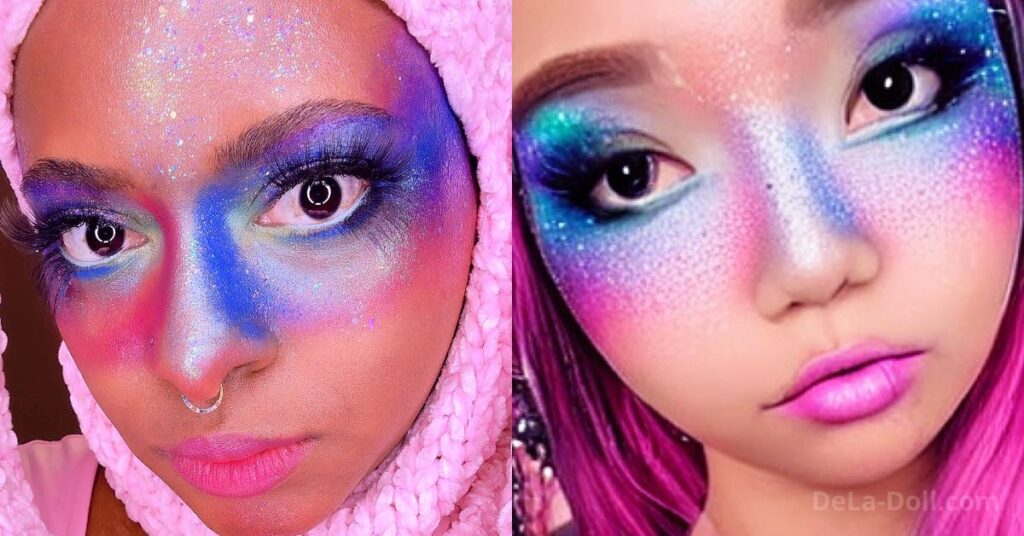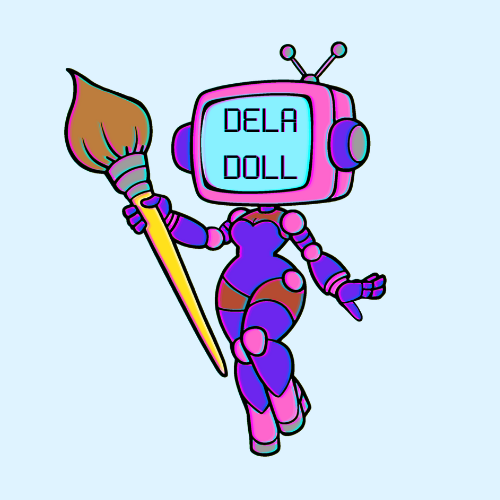
As the title suggests I don’t hate AI art tools. I don’t automatically hate all AI-generated art either. I don’t think it’s inherently evil or bad. This isn’t to say that I don’t share some of the valid concerns of my fellow artists, but that I’m more intrigued than anything else. I have always been a creative person, I have always created and appreciated art using a variety of mediums, and I have always been interested in the intersection of art and technology. In fact, I think they can live together peacefully.
Is AI Art Theft?
The answer is a lot more philosophical than many of us care to acknowledge. While there are many claims that AI Art programs are “stealing” from artists, many of these allegations only hold weight if you consider using references to be stealing. Although I do understand people feeling uncomfortable about the fact that AI can train on any available images without the consent of the owner/creator, I just don’t see how it is entirely different from a person doing the same thing.
I have seen people who are against AI art tools saying that it’s different, but nobody is saying how it’s different. In the end, it just feels like arguing in circles because it seems like a lot of people will say that it’s not the same and then incorrectly “explain” how they think AI art generators work. While it may seem unfair and uncomfortable, using someone else’s art as a reference or source of inspiration is not illegal, and does not require their consent. All artists refer to other art, images, and the world around them to create something new. From what I’ve been able to gather, it seems that AI art tools more or less do the same thing. At best, it seems the issue is ethically murky, but to call it outright theft comes from a place of ignorance about the technology.
How Does Text-to-Image AI Art Actually Work?
Contrary to popular belief, the way most text-to-image AI art is generated does not involve creating a collage of other people’s work, resulting in a Frankenstein monstrosity (or masterpiece — art is subjective, after all). Instead, AI art tools like Stable Diffusion and Midjourney are trained on a series of references to “learn” and create something new based on user input.
The video below explains it better than I can, but to put it simply, text-to-image AI art begins with a random bunch of static, and the AI tries to make sense if that static based on the text prompt until it generates something that looks like the prompt.
For instance, if you wanted an AI image of a cake with white frosting and strawberries, the AI would try to create that based on what shapes and colors it has “learned” are associated with cakes and strawberries. The end result won’t be a collage of preexisting images, but a completely new image. There can be stylistic similarities, but it’s not a collage, and it’s not theft.
What About Signatures and Watermarks?
Unlike people, AI is not sentient and can’t differentiate between certain elements. Instances of AI-generated images containing what appear to be bits of signatures or watermarks are actually the result of the AI seeing certain types of images contain signatures and trying to create its own series of squiggles to mimic a signature. Andrey Usoltsev, the CEO of the company that created the popular and controversial Lensa App, explained as much in an article published on ARTNews.
“He explained that while neural networks are trained on pre-existing images, once the training is done, the AI does not refer back to the vast dataset of images it was trained on. Rather, it has now learned how to mimic particular styles. According to Usoltsev, the AI has learned that a key characteristic of the category “painting” is a signature, so it makes one up.
‘On this occasion, it mimics the paintings, the subset of the images that generally come with sign-offs. AI understands the sign-offs as an inherent style feature and imitates them,” wrote Usoltsev, who added that “The details pointed out don’t use any existing language and do not represent the particular artist’s signature.’”
Source: https://www.artnews.com/art-news/news/signatures-lensa-ai-portraits-1234649633/
So no, AI art is objectively not a collage of other people’s work, not theft as far as the law is concerned, and the squiggles seen in some AI-generated art are not “the remains of the signature of one of the multiple artists it stole from.” AI art generators are merely tools that lack the ability to think, feel, and differentiate the way we can. They are just tools.
AI Art Misuse
Like any tool, AI art technology can be used for good or nefarious purposes. In fact, AI art tools can and have been misused, not because they are inherently evil — they can’t be, they aren’t even alive — but because the intent and actions of the people behind them are impure. I don’t see the use of AI art generators as inherently bad, immoral, or unethical, and I think seeing it that way is dismissive to honest artists who have incorporated it into their workflow as a source of inspiration or an accessibility tool.
On the other hand, if someone were hoping to pass off purely AI-generated art as something that was created in another way, that would obviously be dishonest and shitty. Intentional misrepresentation of one’s skills is always bad no matter what tools were used. Similarly, if someone were to take another artist’s finished or unfinished work and load it into an image-to-image (meaning the process does begin with a specific reference image rather than static and text) AI art generator, then claim it as their own, that would also be really shitty and a prime example of how to misuse a tool.
There are also instances of people using AI art generators to create disturbing and hateful content, but that again comes down to a misuse of the tool. People are always going to find ways in which to do good or harm with new technology. The conclusion to be drawn is that AI art generators are neutral tools, and ultimately people are the ones who decide how to use them.
Why are Some Artists Against AI Art?
New technology will always be met with opposition, justifiable or otherwise. To me, AI art tools and the controversy surrounding them is no different. There is some technology I find deeply troubling, and some I am unsure about. As far as AI art tools go, I am more amused than anything. I create both traditional and digital art, and I remember seeing people react the same way to programs like Photoshop and tools like drawing tablets. Any tech that can potentially disrupt an entire career field and cause some people to lose jobs is going to scare and upset people. I empathize with artists who fear a loss of income as a result of AI technology, but I don’t believe that we will ever stop needing human artists. Personally, I will always love, respect, and support my fellow artists. The human element in art is irreplaceable.
Personal Feelings and Food for Thought
That said, I do think it’s a bit unfair that artists who are not 100% anti-AI are being silenced and shut down in order to perpetuate a narrative that the only “real” or “true” artists all share the same exact same negative thoughts and feelings about it. I understand the desire to resist and reject what feels like a threat to one’s livelihood, but I just don’t think the answer is to harass people using the tools or to perpetuate fear and misinformation. I believe in approaching things from an educated and honest place, and to ignore reality is to be willfully ignorant and dishonest.
Automation has always reshaped our lives and work, so I guess I just don’t see a way forward that could close this particular Pandora’s box. The tech is already here, and it isn’t going to go away. Personally, I choose to learn more about it rather than give in to fearmongering and willful ignorance, and I encourage people on any “side” of the AI art discourse to do the same. If you’re against it, ask yourself how well you can fight an enemy that you don’t know. If you refuse to learn how it works or even acknowledge the pros (which do exist) alongside the cons, what real chance do you have of resisting it, defeating it, or coming to terms with it in whatever way you see fit?
If you’re all for AI art, at least make the effort to learn about how it works and understand why some people may not be as keen on it. Personally, the concept of AI art tools excites me, but that excitement is cloaked in a considerable layer of caution. The concerns I have are related to much larger, much older issues concerning privacy, capitalism, and greed, but these problems existed long before anyone had ever heard of things like the Lensa app.
While I think AI art tools are exciting, I think that those of us who truly love art and respect artists will always continue to support art created by humans in any and every medium. I will never stop drawing, crafting, or painting, but that doesn’t mean I have to reject new tools. Yes, there will be corporations and individuals who think they no longer need “real” artists, but they were never really patrons of the arts anyway, so it’s not a loss. And yes, unfortunately, capitalism forces us to commodify our passions to survive, meaning they are subject to the same corporatism and competition as any other business. It sucks, but that’s another topic for another time.
Ways I Use AI Art as a Tool
While the discourse surrounding AI Art has been fraught with misunderstanding and hostility, I have been experimenting with different generators partially due to curiosity and partially as a source of inspiration. As it turns out, it is a lot harder to get a coherent result than it looks — crafting optimal prompts is an art in itself, it seems. I have been able to produce some interesting images and concepts, but I choose to use them as a starting point rather than viewing them as an end result. For instance, I played around in an AI art app called StarryAI to see if I could get an interesting makeup look, and I ended up really digging the result!
I can definitely see myself continuing to explore this new medium and looking for the good in it. I would rather keep creating art in all its glorious form rather than waste time arguing about what is or isn’t art, or fighting inevitable change.
Final Thoughts on AI Art Tools
Ultimately, I understand people’s apprehension toward AI art generators as much as I understand their excitement. I just wish people would make more of an effort to understand and inform themselves rather than operate off of knee-jerk reactions to something relatively new that we are all still learning about.
I think it’s ok to step back and say that we don’t have all the answers, that there are both valid ethical concerns and potential benefits of AI art tools in terms of accessibility and workflow, and that for better or worse, AI art is here to stay.
DeLa Doll is a multifaceted artist, writer, and creator with a passion for bold self-expression. With a background in professional writing, nail artistry, and makeup, she brings a unique perspective to beauty, creativity, and storytelling. As the driving force behind DeLa Doll, she blends artistry with authenticity, sharing her journey of entrepreneurship, self-discovery, and growth. Whether crafting luxury press-on nails, exploring media through a critical and creative lens, or documenting her evolving artistic vision, DeLa Doll invites her audience into a world where imagination meets intention.



